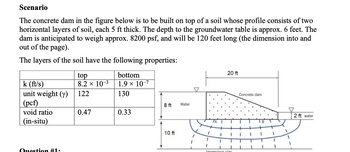
Concept explainers
Please answer all questions based on the scenario
Question #1:
Considering the water upstream of the dam,
a) What will be the seepage loss of that water downstream per year?
b) What will the uplift force be on the dam?
Question #2:
What would the stress in the center of the dam be at the middle of the bottom layer? Consider both the overburden pressure and that due to the loading.
Question #3:
A sieve analysis was performed on a sample of the top layer of the soil, with the results shown below:
|
Sieve Size (in.) |
1/2 |
3/8 |
No. 4 |
No. 8 |
No. 16 |
No. 30 |
No. 40 |
No. 50 |
No. 100 |
No. 200 |
pan |
|
Amount retained (g) |
0 |
0 |
21.6 |
39.5 |
77.6 |
102.6 |
89.1 |
95.6 |
90.6 |
60.4 |
33.3 |
Do the following:
a) Calculate the percent retained and percent passing each sieve, and graph the results on a semi-log graph (you may use the attached chart, or graph in Excel and include with your submission). Then, characterize the gradation of the material.
b) Calculate the values of D10, D30, D60, Cu, and Cc .
c) If the LL is 48 and the PL is 26, determine the USCS classification of the soil, and state its suitability for the purpose stated in the scenario.
Question #4:
It has been anticipated that the soil under the proposed dam is contaminated, and needs to be removed and backfilled to a depth of 2.5 feet. A Standard Proctor compaction test was conducted on soil from a borrow pit, with the results shown below right. Based on the results:
a) Plot the Proctor curve for the borrow
b) Find the optimum water content and dry unit weight for the borrow soil.
c) Determine whether the unit weight of the top layer can be met by compacting to 95% of maximum, and what the range of moisture content for that unit weight
d) Suggest a compaction method for this borrow soil (equipment and method) based on the type of soil indicated in Question #1.
e) If we borrow soil from a pit with a void ratio of 0.71, determine how much soil we need to borrow to backfill below the dam to match the in-situ void ratio of the top layer of
|

Trending nowThis is a popular solution!
Step by stepSolved in 4 steps with 6 images

- A flexible steel platform has a footprint of 75 feet by 75 feet and supports equipment having a total weight of 2,250 kips. The platform is located at the ground surface. The soil profile below the platform consists of 30 feet of stiff clay over bedrock. The groundwater table is located 5 feet below the ground surface. The clay has a unit weight of 120 pcf above the water table and 125 pcf below the water table. Laboratory consolidation test results for a sample of the clay at a depth of 15 feet below the ground surface reveal a preconsolidation stress of 2,400 psf, compression index of 0.5, recompression index of 0.1 and initial void ratio of 0.66. Assume the bedrock is incompressible. Part A Plot effective vertical stress versus depth (to scale) before and after installation of steel platform and equipment. Part B Calculate the primary consolidation settlement at the center of the platform and at the corner of the platform AND report the differential settlement between these two…arrow_forwardDefine Mohr–Coulomb Failure Criterionarrow_forwardHow does the primary (consolidation) compression—occurs rapidly even in fully saturated coarse-grained deposits?arrow_forward
- I need the answer as soon as possiblearrow_forwardDescribe about the Unconsolidated–undrained (U–U) triaxial test data relationship between total stress, effective stress, and pore water pressure.arrow_forwardGiven the following lab data, calculate the pore volume compressibility for a sandstone sample at 4,000 and 6,000 psi. Pore volume of the sandstone sample is 50 cm3. Pressure, psi Vol. fluid expelled, cm3 1000 0.244 2000 0.324 3000 0.392 4000 0.448 5000 0.5 6000 0.546 7000 0.596 8000 0.63arrow_forward

 Structural Analysis (10th Edition)Civil EngineeringISBN:9780134610672Author:Russell C. HibbelerPublisher:PEARSON
Structural Analysis (10th Edition)Civil EngineeringISBN:9780134610672Author:Russell C. HibbelerPublisher:PEARSON Principles of Foundation Engineering (MindTap Cou...Civil EngineeringISBN:9781337705028Author:Braja M. Das, Nagaratnam SivakuganPublisher:Cengage Learning
Principles of Foundation Engineering (MindTap Cou...Civil EngineeringISBN:9781337705028Author:Braja M. Das, Nagaratnam SivakuganPublisher:Cengage Learning Fundamentals of Structural AnalysisCivil EngineeringISBN:9780073398006Author:Kenneth M. Leet Emeritus, Chia-Ming Uang, Joel LanningPublisher:McGraw-Hill Education
Fundamentals of Structural AnalysisCivil EngineeringISBN:9780073398006Author:Kenneth M. Leet Emeritus, Chia-Ming Uang, Joel LanningPublisher:McGraw-Hill Education
 Traffic and Highway EngineeringCivil EngineeringISBN:9781305156241Author:Garber, Nicholas J.Publisher:Cengage Learning
Traffic and Highway EngineeringCivil EngineeringISBN:9781305156241Author:Garber, Nicholas J.Publisher:Cengage Learning





